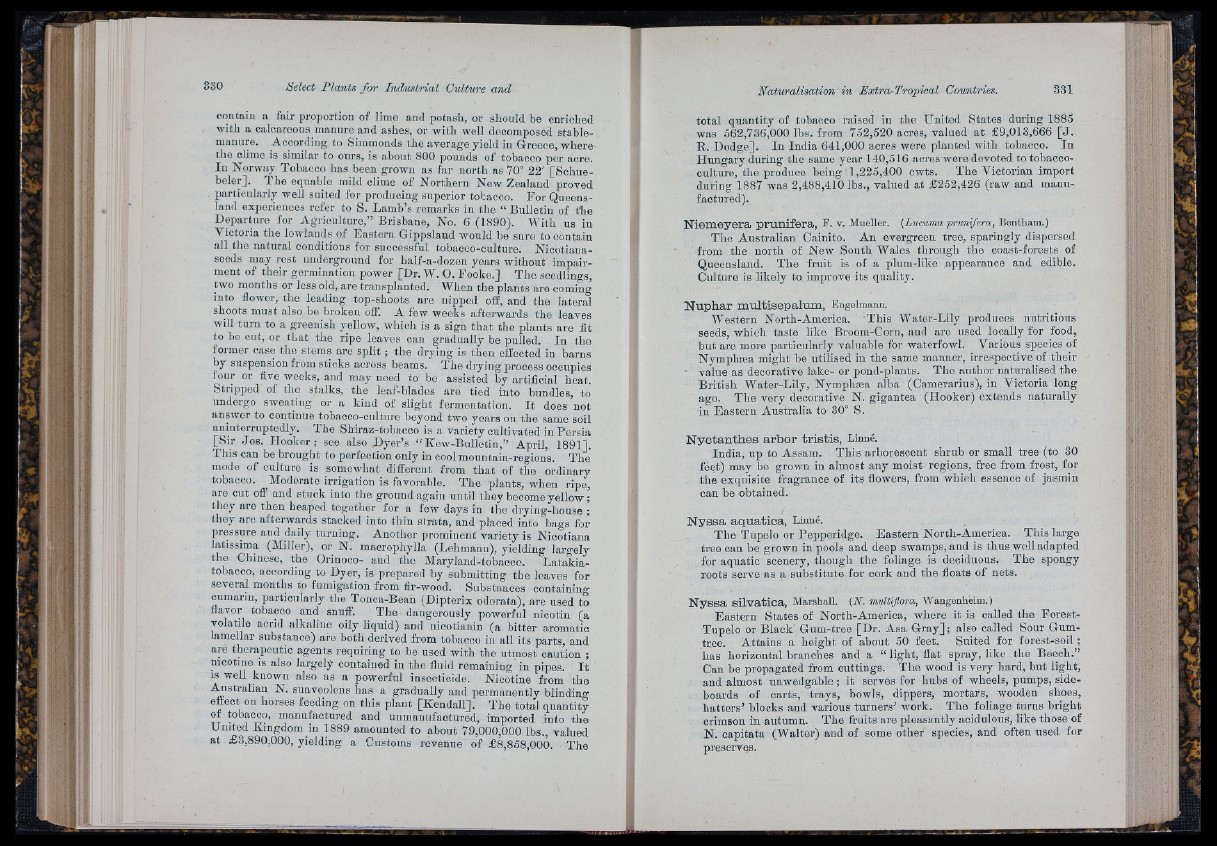
i ' ' i:
contain a fair proportion of lime and potash, or should be enriched
with a calcareous manure and ashes, or with well decomposed stable-
manure. According to Simmonds the average yield in Greece, where
the clime is similar to ours, is about 800 pounds of tobacco per acre.
In Norway Tobacco has been grown as far north as 70° 22' [Schuebeler].
'The equable mild clime of Northern New Zealand proved
particularly well suited for producing superior tobacco. For Queensland
experiences refer to S. Lamb’s remarks in tlie “ Bulletin of the
Departure for Agriculture,” Brisbane, No. 6 (1890). With us in
Victoria tlie lowlands of Eastern Gippsland would be sure to contain
all tlie natural conditions for snooessfnl tobacco-ciilture. Nicotiana-
seeds may rest underground for half-a-dozen years without impairment
of their germination power [Dr. W. O. Fooke.] 'The seedlings,
two months or less old, are transplanted. When the plants are coming
into flower, the leading top-shoots are nipped off, and the lateral
shoots must also be broken off. A few weeks afterwards the leaves
will turn to a greenish yellow, which is a sign th a t the plants are fit
to be cut, or that the ripe leaves can gradually be pulled. In the
former case the stems are split ; the drying is then effected in barns
by suspension from sticks across beams. 'The drying process occupies
four or five weeks, and may need to be assisted by artificial heat.
Stripped of the stalks, the leaf-blades are tied into bundles, to
undergo sweating or a kind of slight fermentation. I t does not
answer to continue tobacco-culture beyond two years on the same soil
iminterruptedly. The Shiraz-tobaoco is a variety cultivated in Persia
[Sir Jos. Hooker; see also Dyer’s “ Kew-Bulletin,” April, 1891].
This can be brought to perfection only in cool mountain-regions. 'The
mode of culture is somewhat different from th a t of the ordinary
tobacco. Moderate irrigation is favorable. The plants, when ripe,
are cut off and stuck into the ground again until they become yellow ;
they are then heaped together for a few days in the drying-house ;
they are afterwards stacked into thin strata, and placed into bags for
pressure and daily turning. Another prominent variety is Nicotiana
latissima (Miller), or N. macrophylla (Lehmann), yielding largely
the Chinese, the Orinoco- and the Maryland-tobacco. Latakia-
tobaoco, according to Dyer, is prepared by submitting the leaves for
several months to fumigation from fir-wood. Substances containing
cumarin, particularly tlie Tonca-Bean (Dipterix odorata), are used to
flavor tobacco and snuff. The dangerously powerful nicotin (a
volatile acrid alkaline oily liquid) and nicotianin (a bitter aromatic
lamellar substance) are both derived from tobacco in all its parts, and
are therapeutic agents requiring to he used with the utmost caution ;
nicotine is also largely contained in the fluid remaining in pipes. I t
is well known also as a powerful insecticide. Nicotine from the
iListrahan N. suaveolens has a gradually and permanently blinding
eflect on horses feeding on this plant [Kendall]. The total quantity
of tobacco, manufactured and unmanufactured, imported into the
United Kingdom in 1889 amounted to about 79,000,000 lbs., valued
a t £3,890,000, yielding a Customs revenue of £8,858,000. The
total quantity of tobacco raised in the United States during 1885
was 562,736,000 lbs. from 752,520 acres, valued a t £9,013,666 [ J .
R. Dodge]. In India 641,000 acres were planted with tobacco. In
Hungary during the same year 140,516 acres were devoted to tobacco-
culture, the produce being 1,225,400 cwts. The Victorian import
during 1887 was 2,488,410 lbs., valued at £252,426 (raw and manufactured).
Niemeyera prunifera, P. V. Mueller. (Lucuma prunifera, Bentham. )
The Australian Cainito. An evergreen tree, sparingly dispersed
from the north of New. South Wales through the coast-forests of
Queensland. The fruit is of a plum-like appearance and edible.
Culture is likely to improve its quality.
Nuphar multisepalum, Engelmann.
Western North-America. -'This Water-Lily produces nutritions
seeds, which taste like Broom-Corn, and are used locally for food,
but are more particularly valuable for waterfowl. Various species of
Nymphæa might be utilised in the same manner, irrespective of their
■ value as decorative lake- or poud-plants. 'The author naturalised the
British Water-Lily, Nymphæa alba (Camerarius), in Victoria long
ago. The very decorative N. gigantea (Hooker) extends naturally
in Eastern Australia to 30° S.
Nyctanthes arbor tristis, Linné.
India, up to Assam. This arborescent shrub or small tree (to 30
feet) may be grown in almost any moist regions, free from frost, for
, the exquisite fragrance of its flowers, from which essence of jasmin
can be obtained.
N y ssa aquatica, Linné.
The 'Tupelo or Pepperidge. Eastern North-America. This large
tree can be grown in pools and deep swamps, and is thus well adapted
for aquatic scenery, though the foliage is deciduous. The spongy
roots serve as a substitute for cork and the floats of nets.
Ny ssa silvática, Marshall. (N. multiflora, Wangenheim.)
Eastern States of North-America, where it is called the Forest-
Tupelo or Black' Gum-tree [Dr. Asa G ray ]; also called Sour Gum-
tree. Attains a height of about 50 feet. Suited for forest-soil ;
has horizontal branches and a “ light, flat spray, like the Beech.”
Can be propagated from cuttings. The wood is very hard, hut light,
and almost unwedgable ; it serves for hubs of wheels, pumps, sideboards
of carts, trays, bowls, dippers, mortars, wooden shoes,
hatters’ blocks and various turners’ work. 'The foliage turns bright
crimson in autumn. The fruits are pleasantly acidulous, like those of
N. capitata (Walter) and of some other species, and often used for
preserves.